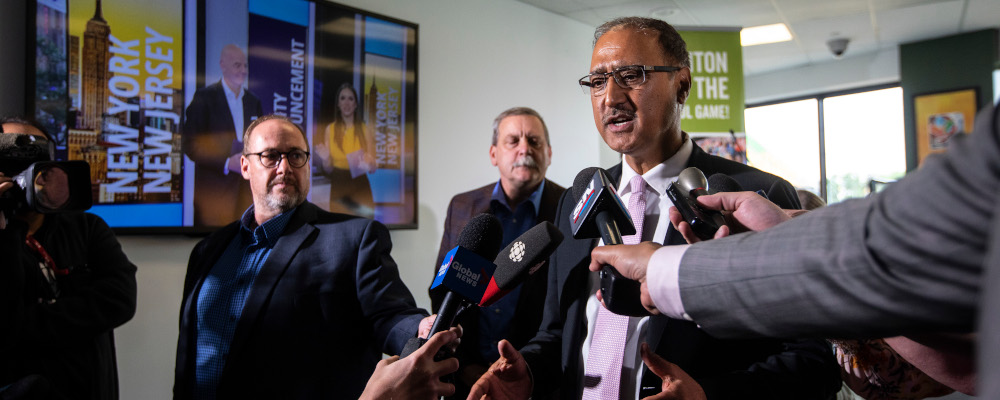The news media in Canada is in crisis. Policy responses to date are failing to solve for the information that citizens need to make informed decisions about important issues and debates. The Future of News series brings together leading practitioners, scholars, and thinkers to imagine new business models, policy responses, and journalistic content that can support a dynamic future for news in Canada.
One week into my journalism degree in 2008, Lehman Brothers collapsed and the economy tanked. Everyone was nervous. Even President Bush looked scared. The question on everyone’s minds in my class at UBC: “Will we still get our summer internships?”
We did. The crisis passed. I graduated in 2010 and went to Maclean’s, the newsroom of my dreams while my colleagues went to places like the Globe, the Star, Global, and CBC. I was at the very bottom of the masthead and mostly covering education, but my name appeared alongside Coyne and Wells and I learned from editors who didn’t give a damn if they got denounced in the House.
At first, I didn’t think much about revenue. We could spend days on a one-page story, fly to universities to report, and hire top photographers. We had around 350,000 subscribers. The magazine was bringing in tens of millions from ads.
It was stunning how quickly things collapsed. When I left in 2014, Maclean’s seemed doomed. Freelance budgets had been cut to nearly zero. We’d spent years redesigning a website and repurposing the magazine for tablets which we could already see were a passing fad. The celebratory launch dinner felt like a funeral.
So what had happened? Google and Facebook could reach more eyeballs for a fraction of the cost, since their ads were placed beside content that users mostly created for free. Plus, their technology collected dozens of demographic data points on each user allowing their ads to target people with precision.
In 2014, I went to work for CTVNews.ca. CTV’s ad revenue was also shrinking but it had two big sources of cash to cushion the decline. The CRTC required every person who subscribed to cable in Canada to pay $1 to CTV News Channel. That was $10 million a year of guaranteed revenue. Plus the CRTC required dozens of local dinner-hour news shows be created in exchange for CTV being allowed to show Big Bang Theory and Grey’s Anatomy, and we could repurpose that content.
By 2019, when I left journalism for law school, Maclean’s was nearly gone and CTV’s future seemed shaky. CTV was losing eyeballs to Netflix and Amazon and it felt like only a matter of time before the subscriber-fees model would disappear too. By then, my graduating class at UBC’s Class of 2010 had nearly all left for communications.
I was lamenting all this a couple weeks ago when speaking with an Edmonton Journal reporter about the Canadian Constitution Foundation’s recent letter to the City of Edmonton explaining why they can’t require journalists to seek permission or notify them before reporting on transit property without violating freedom of expression. The reporter knew this had to be the case, but with a newsroom that had shrunk to just a handful of reporters (one on weekends!) covering a region of two million, she didn’t have much time to look into it—or fight back.
Hundreds of excellent Substacks, specialty sites and podcasts have bloomed in Canada as the legacy media has declined, but no one has yet figured out a business model that can do things like enterprising reporting on the scale that Maclean’s or CTV once did. Statistics Canada counted about 13,000 journalists in 2013. In 2020, it counted 6,275.
With the number of journalists in Canada falling, government communications staff seem to be going in for the kill. There are now so few journalists that governments easily get away with holding back information that we have a right to know. We have got to fix this.
Edmonton’s policy is just one example. The policy sent out in a recent news release stated that reporters must “notify the City of Edmonton prior to reporting, filming or conducting business on ETS property” and “contact ETS Communications” to “gain access.” I suspect Edmonton doesn’t want people to see how, despite hordes of peace officers patrolling the premises, drug users continue to use the stations to find a warm place to inject, making transit users nervous.
Either way, this is unconstitutional. The Supreme Court of Canada said in a 1991 case that airport and bus terminals are “contemporary crossroads” that must be accessible for exercising one’s freedom of expression. “Freedom of the press and other media of communication” is specifically spelled out in the Charter’s section 2(b) expression guarantee. But it’s tough for journalists to assert their rights when they now have to write multiple stories daily. They lack strength in numbers.
Toronto’s Pearson Airport may have gotten away with a similar policy. After a summer of bad press, the airport told journalists that they had to fill out a “request form 24 hours before sending crews to the airport, whether reporting from inside a terminal or outside…” so that the comms team could “approve or deny requests.” Like Edmonton, Pearson soon claimed that the policy of requiring permission didn’t exist. But a year later, Pearson still says on their website that media wishing to film “must register” in advance and seek permission before filming individuals.
Another example of governments taking advantage of the media’s dwindling clout to withhold information is Daniel Otis’ fight for documents from Ontario Power Generation (OPG). Otis is a freelance journalist who covers UFOs for publications like Vice and CTV News. In early 2022, Otis made access to information requests to OPG and New Brunswick Power seeking records of UFOs and UAP detections near Canada’s nuclear generating stations. Both organizations originally rebuffed him. NB Power cited national security. OPG cited a “danger to safety or health.”
Otis doesn’t take no for an answer so he appealed both decisions. NB Power relented and provided redacted records while OPG responded by claiming 11 further sections of the Freedom of Information and Privacy Protection Act. This is despite the Act making clear that its very purpose is to make information available to the public, with only “limited and specific” exemptions, and the clear public interest in knowing whether our nuclear plants are properly protected.
OPG probably thinks that they can get away with shielding these documents by siccing their lawyers on Otis since he’s a freelancer without in-house legal support. That may have been true had the CCF not stepped in to assist him with the days of legal research and writing required. Most journalists would be forced to give up.
Otis is not alone. On a recent episode of the podcast Canadaland, Drew Anderson from the environmental publication The Narwhal told the host that there had been a marked shift toward less access to information under the government of Premier Danielle Smith. “You request information, they just redact it as a matter of course and say ‘fight me,’” Anderson said. “It wears you down.”

So what can be done?
First, we need to deal with the elephant in the room. The CBC produces a pitiful amount of investigative journalism considering the $1.4 billion annual cheque that taxpayers write. That’s because surprisingly little of that goes to news, rather than things like The Great Canadian Baking Show and CBC Music that the public shouldn’t be subsidizing at all. Ottawa should defund CBC. It can continue to exist if it shifts to a subscriber model or people choose to donate, but journalists should no longer have to compete with a taxpayer-funded behemoth that can afford to give away its content for free while devouring what’s left of the advertising market.
The government could move some of that money into providing much bigger tax breaks to support enterprising journalism. They could make newspaper, Substack, and podcast subscriptions mostly tax deductible so that more people and businesses are incentivized to subscribe, and so that startups like Canadaland, Blacklock’s, and The Hub can afford to do more investigative journalism.
The government might also consider shifting some of CBC’s funding into an entity like CPAC that could send a camera operator to scrums and news conferences on Parliament Hill, and in every town, city, and First Nation of a certain size, to collect video and audio that could then be used for free by any Canadian doing any kind of reportage.
But the government can’t be the main solution because a government-funded press will always be, to some degree, biased toward the hand that feeds them. You and I need to be the solution. We need to subscribe again. Subscribe to newspapers. Subscribe to podcasts. Donate to organizations like The Hub that are investing in journalism. If more of us don’t start subscribing, then governments will get away with keeping even more things secret that the public has a right to know.
The Future of News series is supported by The Hub’s foundation donors and Meta.
Recommended for You

‘We are not the United States. No one needs to own Canadian bonds’: Rudyard Griffiths and Sean Speer on Canada’s looming debt crisis

DeepDive: Bridging the imagination gap: Why Canadian businesses must rethink AI adoption now

Peter Menzies: Travis Dhanraj’s CBC resignation reveals the truth about media ‘diversity’ in Canada

‘Not a guide to practical action’: David Frum on 60 years of George Grant’s Lament for a Nation



